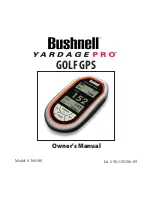
1-28 TM106601_(7/01)
USE OR DISCLOSURE OF DATA CONTAINED ON THIS PAGE IS SUBJECT TO THE
RESTRICTION ON THE TITLE PAGE OF THIS DOCUMENT
.
C
O M M A N D
S
Y S T E M S
D
I V I S I O N
Note
+
Pulse spacing is determined by Motorola
specifications for the SST-181E X-band radar
transponder.
(c) Sequentially press the PUSH CODE button, and observe the code number that appears on the
display. (e.g. B1, B2, B3, …, B9).
(d) Stop pressing the PUSH CODE button when code B3 appears
(e) Fly the aircraft until a beacon symbol appears on the screen. If it is the desired beacon, B3 will
appear above the first mark in the beacon return.
Note
+
Range must be set between 2 miles minimum
and 80 miles maximum for 2-pulse beacon
identification to function. No decoding will
occur beyond 80 miles or less than 2 miles.
Also, for optimum identification, adjacent
numbered codes should not be assigned to
transponders in the same area. Refer to
Table 1.6-4.
1.6.4.10 DO-172 Six-Pulse Beacon Interrogation
The DO-172 6-pulse beacon transponder produces a display (reply) similar to the standard 2-pulse
beacon transponder reply previously described. Each DO-172 beacon location will appear as two
curved lines (frame marks) on the screen, with one, two, three, or four additional curved lines
between the two frame marks. The number of curved lines between the frame marks, and the
spacing of the lines, is determined by the beacon code of the transponder. For example, assume that
the reply for beacon code A15 is being displayed. The binary code for 15 is 1111, so there will be
four equally spaced lines between the two frame marks. Beacon code A13 would appear as a line,
then a space, then two more lines between the frame marks, for binary number 13. The first line after
the first frame mark represents the least significant bit in the binary number (e.g. number 1101 will
appear as 1011).
Depending upon the display range selected and the location of the beacon, the lines between the
frame marks may be too close to distinguish or properly identify the number, and should not be used
for identifying the reply. The PUSH CODE button on the radar control panel permits identifying each
DO-172 beacon reply in the same manner as the 2-pulse beacon reply previously described, except
15 beacon codes are possible with the DO-172 6-pulse beacon.
A pulse from the radar transmitter interrogates the DO-172 beacon. The interrogation frequency is
between 9370 MHz and 9380 MHz. The pulse width is between 2.20 µsec and 2.65 µsec. When the
DO-172 beacon transponder receives the pulse at the proper amplitude, a reply is transmitted at 9310
MHz ±5 MHz after a fixed delay of 4.7 µsec. The beacon reply signal consists of two-to-six pulses
spaced at intervals of 3.0 µsec between leading edges. Each pulse is 0.5 µsec wide. The f irst pulse is














































